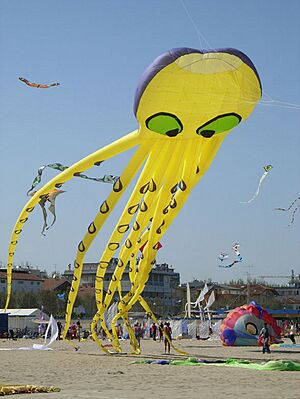Inflatable single-line kite facts for kids
An inflatable single-line kite is a special kind of kite that gets its shape from air pressure. Unlike many traditional kites, these don't have stiff poles or frames. Instead, they fill up with air, much like a bouncy castle or a hot air balloon. This clever design makes them strong and able to fly high.
These kites are a modern invention in the world of kite flying. An inventor named Domina Jalbert patented a key design called the "parafoil" in 1944. This design helped create many of the inflatable kites we see today.

Inflatable kites are often made from strong, lightweight fabrics. These fabrics allow the kite to form amazing three-dimensional shapes. The air pressure inside the kite is slightly higher than the air outside. This small difference is what keeps the kite's shape firm while it flies.
You can find inflatable kites in many fun shapes. Some look like fish, cats, or other animals and characters. They can be small, around 2 meters long, or incredibly huge, up to 65 meters! The biggest kites in the world are often inflatable single-line kites. They are designed by a New Zealand kite maker named Peter Lynn.
How Inflatable Kites Work
Inflatable kites are often called "ram-air" kites. This means they scoop up air as they fly. They have special openings, usually at the front, that let air flow in. This air fills up the kite and gives it its shape.
These kites also have a special set of lines called a bridle. The bridle connects the main flying line to many different points on the kite. This helps to spread the pull evenly across the whole kite. It makes the kite stable and strong in the wind. Because they don't have rigid parts, these kites can be packed down small when not in use.
Different Kinds of Inflatable Kites
There are a few different types of inflatable single-line kites:
- Soft, Flexible Kites: These kites rely only on ram-air inflation. They are completely soft and flexible.
- Ram-Air Kites with Spars: Some inflatable kites use ram-air inflation but also have a few flexible poles, called spars. These spars help give the kite extra shape or support.
- Gas-Filled Kytoons: A kytoon is a mix between a kite and a balloon. They can be filled with air, helium, or hydrogen gas. If the kytoon is heavier than air, it needs wind to fly like a regular kite. If it's lighter than air (like a helium balloon), it can stay up even when there's not much wind.
- Mixed Inflation Kites: Some kites combine both ram-air inflation and gas-filled bladders. This means they get their shape from both scooped-up air and gas inside special pockets.

